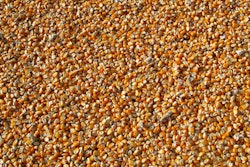
According to the Foreign Agricultural Service of the U.S. Department of Agriculture (USDA), Brazil is set to have another record-breaking grain harvest in 2022/2023 with wheat production estimated at 9.6 million tonnes and corn production at 125.5 million tonnes.
Corn
The latest Brazil: Grain and Feed Update report notes corn production is up 8% from the estimated 116 million tonnes for 2021/2022. Due to continued interest in international markets, corn exports are forecast at 47 million tonnes in 2022/2023.
Corn is planted in Brazil year-round. First-season corn, also referred to as “summer corn,” is traditionally cultivated in the south of Brazil, with some areas being sown in the south and northeast states. It is usually planted between August and December and harvested between January and June and currently accounts for roughly 21% of all corn production in the country.
Second-season corn, commonly referred to as ‘safrinha’ corn, is planted from December to March, usually following the soybean harvest, and comprises the most extensive area, accounting for most of the production (roughly 77% in the 2022/2023 harvest estimate).
Lastly, Brazil also established a third-season corn crop, planted only in some states of the country’s North and Northeast. Due to the region’s climate, this crop cycle resembles that of the U.S., with planting occurring around May and harvesting in October. This corn cycle accounts for approximately 2% of corn production and presents lower yield rates, averaging 3.5 million tonnes/acre, while first-season corn is estimated to average 6 million tonnes/acre.
Many analysts credit the lower productivity of third-season corn to the lesser use of technology in the region as farmers traditionally destine their harvest for livestock feed.
Wheat
Brazil is also expected to reach record wheat production. The USDA report forecasts wheat production for at 9.6 million tonnes in 2022/2023 and raises its forecast for wheat export to 3.5 million tonnes on a wheat grain equivalent basis (WGE), up 6% from its previous estimate.
This increase in production is justified by the improvement of existing agricultural production systems, with wheat in crop rotation, better use of areas that were traditionally idle in winter, and investment in technologies, including new resistant cultivars adapted to different climates and diseases.
According to projections by the Brazilian Agricultural Research Corporation (EMBRAPA), if wheat production continues to grow 10% yearly, Brazil could reach 20 million tons of wheat by 2030. With domestic consumption estimated at 12 to 14 million tons, Brazil would shift from an importer to an exporter of wheat to the world.
Almost 90% of the Brazilian wheat crops are planted in the southern states of Paraná, and Rio Grande do Sul. The country sows most of its wheat between April and September, depending on the region. Still, the planting timeline falls outside USDA’s market year, which runs from October to September of the following year. However, the wheat crop harvest and export occur within the market year parameters.
Argentina is the biggest supplier of wheat to Brazil, but the severe drought, followed by several episodes of frost, should reduce the Argentine wheat harvest. The report contacts estimate that Brazil has been turning to suppliers such as Russia, the U.S. or the European Union due to the drop in the Argentine crop to fulfill its demand. In fact, Russia has been back on the list of top exporters to Brazil in the last couple of months.

















